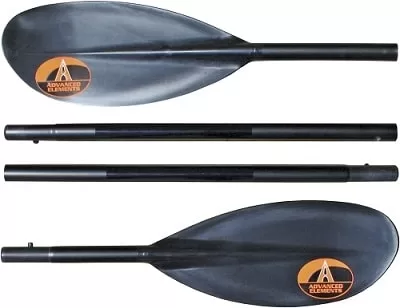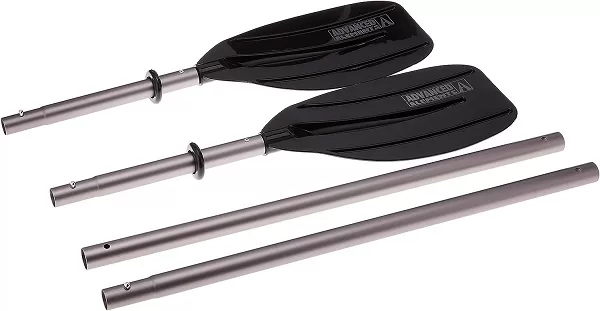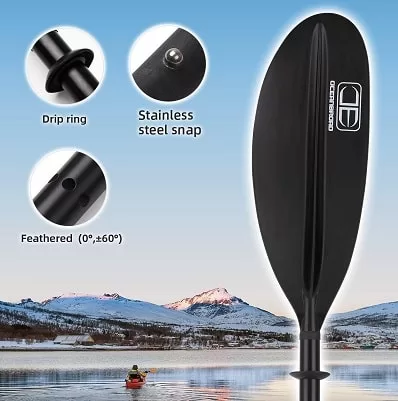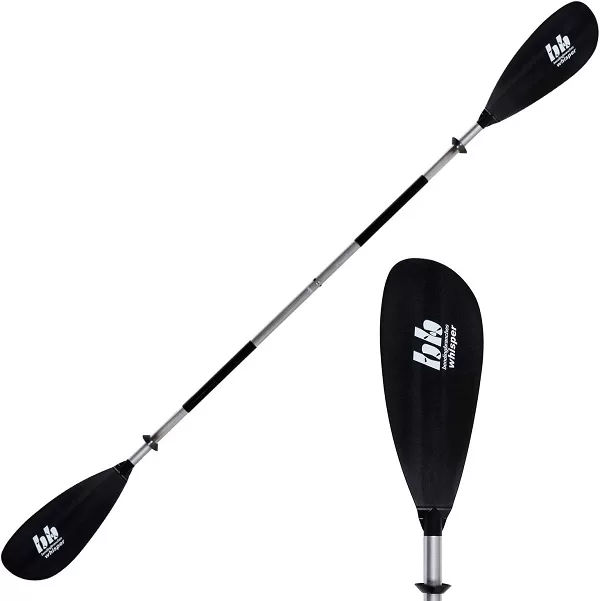Are you a canoe enthusiast looking to switch things up and try using a kayak paddle? Or maybe you’re curious if it’s possible to use a kayak paddle for canoe.
Yes, a kayak paddle can be used for a canoe, but there are considerations. The recommended paddle length is typically between 260 cm to 280 cm. While canoe paddles are more efficient, a kayak paddle can still be effective. However, a kayak paddle may provide a different level of effectiveness than a canoe paddle.
Canoe and kayak paddles may differ in many aspects, but can they work together harmoniously? Let’s find out! We’ll cover everything from the ideal paddle length and blade size to the pros and cons of using a kayak paddle for a canoe. So, grab your life jacket, and let’s get started!
Key Takeaways On Using Kayak Paddle For Canoe
Can I go solo canoe with kayak paddle – Yes, you can go solo canoeing with a kayak paddle. While a single-bladed canoe paddle is a traditional choice for solo canoeing, a double-bladed kayak paddle can also be used. Kayak paddles can provide faster speeds, less wrist strain, and better efficiency, making them a good choice for solo canoeing.
Difference Between a Canoe Paddle and a Kayak Paddle – Canoe paddles are longer and wider than kayak paddles, held at an inclination close to parallel with the water and require more skill to use effectively.
Kayak paddles have smaller blades, are held at a more horizontal angle, and can provide faster speeds, less wrist strain, and better agility.
Choosing kayak paddle for Canoeing – When choosing a kayak paddle for canoeing, consider factors such as length and blade size, blade material and weight, skill level and paddling style, budget and price range, and ergonomics and comfort.
It is recommended to try out different paddle lengths and sizes to find the one that feels most comfortable and efficient for your specific canoeing needs.
Can You Go canoe with kayak paddle?
Yes, you can use a kayak paddle for a canoe. But there are a few things to consider when using a kayak paddle with a canoe:
Length:
Because you sit higher in a canoe than in a kayak, canoe paddles are often longer. The length of the paddle is crucial for effective and pleasant paddling.
For many solo canoeists, the 240–250 cm length of most kayak paddles may not be sufficient. But a kayak paddle might work if you paddle in a pack canoe with a lower seat.
Efficiency:
Kayak paddles are made specifically for kayak use and are more effective when seated. Due to their twin blades, paddling is quicker and less physically demanding.
On the other hand, canoe paddles are normally single-bladed. While a kayak paddle can be used with a canoe, it might not be as effective as doing so.
Adapters:
You can change a canoe paddle into a double-bladed one or vice versa using adapter grips. These adapters might provide greater flexibility and let you utilize the paddle that best suits your requirements.
Advantages of using a Double-Bladed Kayak Paddle for Canoe
- Faster Speed:
A double-bladed paddle allows for a more efficient and powerful stroke than a single-bladed one. The symmetrical design of the double-bladed paddle enables you to apply power on both sides of the canoe simultaneously, resulting in faster cruising speeds.
This can be particularly beneficial for long-distance touring or when you need to cover more ground quickly.
- Less Wrist Strain:
The use of a double-bladed paddle can help reduce wrist strain and fatigue. A double-bladed paddle distributes the load evenly between both hands, reducing the strain on the wrists.
This can be advantageous for individuals with wrist pain or injuries, allowing them to paddle for longer periods without discomfort.
- Easier Maneuverability:
The double-bladed paddle provides better steering in certain situations. The ability to paddle on both sides of the canoe simultaneously allows for quick and precise turning.
This makes it ideal for navigating through tight spaces, maneuvering in rapids, or dealing with strong currents like during whitewater canoeing. This can enhance your control and responsiveness on the water.
- Less Switching Sides:
Unlike a single-bladed paddle, a double-bladed paddle eliminates the need to switch sides of the boat as you paddle.
This can be more efficient and less tiring, as you can maintain a consistent paddling rhythm without interruption. It also allows for a continuous and smooth stroke, providing a more enjoyable paddling experience.
- Less Wind Affect:
When paddling in windy conditions, the second blade of a double-bladed paddle can help to counteract the effects of the wind. By having a blade on each side of the paddle, you can maintain better control and stability, keeping the canoe on course even in gusty conditions.
This can be particularly advantageous when paddling across open water or areas prone to strong winds.
Downsides of Going canoe with kayak Paddle
- Lack of Leverage:
One of the biggest drawbacks of canoeing with a kayak paddle is that it can not offer enough leverage. Longer canoe paddles generally enable better reach and more effective strokes.
It could be more difficult to paddle properly and efficiently using a kayak paddle because it has different leverage.
- Fatigue and Muscle Aches:
Undoubtedly, canoeing is a great exercise, but Paddles for kayaks are made specifically for them and are made to be used while seated. They can make you feel exhausted and sore after using a canoe. Repeatedly using a double-bladed paddle in a canoe can cause soreness and muscle strain.
- Less Maneuverability:
The purpose of canoe paddles is to improve paddling maneuverability. They have a single blade, which makes steering and control more accurate.
Double-bladed kayak paddles may offer a different degree of maneuverability, particularly in small or confined locations.
- Different Blade Angle:
Paddle blade angles vary between canoe and kayak paddles. The paddling motion of a canoe is better suited to the more vertical blade angle of canoe paddles.
Paddles for kayaks feature a more horizontal blade angle, which is ideal for paddling when seated. Due to the change in blade angle, using a kayak paddle in a canoe would offer a different efficiency and effectiveness.
Can I still use a kayak paddle for a wider canoe – What are the limitations?
Yes, you can still use a kayak paddle for a wider canoe, but there are some limitations.
The length of a kayak paddle will naturally be longer when used in a canoe because of the wider design, higher sides, and raised seats.
Canoe paddles have longer and wider blades than kayak paddles, which allows them to have more surface area to push against the water. This can make them more effective for paddling a wider canoe. Using a kayak paddle with a wider canoe may result in less effective paddling due to the smaller blade size.
Canoe paddles are held at an inclination close to parallel with the water, which provides better visibility while paddling a canoe. Using a canoe paddle with a kayak may reduce visibility due to the wider blade size.
Using a kayak paddle in a 2-3 person or in a family canoe can be more challenging due to the size and weight of the canoe, less effective steering, the need to switch sides, and the potential influence of wind.
What is the difference Between a Canoe Paddle and a Kayak Paddle?
| Canoe Paddle | Kayak Paddle |
| Wider Blade | Smaller Blade |
| More effective for canoeing | More Effective for Kayaking |
| Povides better leverage and efficiency | Provides faster speeds, less wrist strain, and better maneuverability |
| May have less visibility in a kayak | Provides better visibility in a kayak |
| Generally longer and wider | Generally shorter and narrower |
| Available in length increments of 3 or 2 inches | Available in various lengths depending on the paddler’s height and kayak width |
| Can be used for kayaking, but may not be as efficient | Can be used for canoeing, but may not be as effective |
| Held at an inclination close to parallel with the water | Held at a more horizontal angle |

Choosing a kayak paddle for Canoeing
Paddle Length and Blade Size
Your height and the canoe’s breadth decide the paddle’s length. Longer paddles are typically needed for broader canoes and taller paddlers.
Blade size also impacts performance, with larger blades delivering more power but demanding more work. For more mobility and a lighter paddling experience, smaller blades are preferable.
Paddle Material and Weight
The materials used to make kayak paddles include aluminum, fiberglass, and carbon fibre. Each material has pros and cons regarding weight, cost, and durability.
Although more expensive, lighter materials like carbon fiber offer superior performance and less fatigue during extended paddling trips.
Skill Level and Paddling Style
You should also think about your level of expertise and preferred paddling technique. A smaller blade and shorter-length paddle may be more manageable for beginners.
Advanced paddlers could use longer paddles and larger blades for greater power and efficiency. Your choice of paddle will also depend on your paddling technique, whether low-angle or high-angle.
Budget and Price Range
When selecting a kayak paddle, take your budget into account. Paddle prices might vary greatly depending on the material, manufacturer, and features. Set a budget and search for paddles that are the greatest value for your requirements within that range.
Ergonomics and Comfort
The paddle shaft and grip designs can significantly impact comfort and ergonomics. If you plan to paddle for an extended period of time, look for paddles with ergonomic shaft shapes and soft grips to lessen the strain on your hands and wrists.
Shaft Design and Grips
The paddle shaft and grip designs can significantly impact comfort and ergonomics. If you plan to paddle for an extended period of time, look for paddles with ergonomic shaft shapes and soft grips to lessen the strain on your hands and wrists. Oval-shaped shafts offer a more comfortable grip and can impact how the paddle feels overall.
Blade Shape and Angle
The blade’s shape and angle influence the efficiency and performance of the paddle. Different blade forms, such as dihedral or flat, offer varying stability, power, and manoeuvrability qualities. The efficiency of your strokes can be impacted by blade angle, which is the angle at which the blade meets the shaft.
Backrests and foot braces
Backrests and foot bracing on some canoes may impact the paddle length you select. If your canoe has these traits, think about how they might affect how you paddle and how long of a paddle you’ll need.
How Long & Wide Should a Kayak Paddle Be for a Canoe?
Most canoers require a paddle in the 52″ to 60″ range, with sizes typically offered in 2″ increments.
For choosing the length and width of a kayak paddle for a canoe, you might want to consider the following guidelines:
- If the canoe is over 34 inches wide, a kayak paddle measuring 98.5 inches long (250 centimeters) is recommended.
- For solo canoeists, the recommended paddle length can vary depending on the body size and width of the canoe. Recommendations range from 260 to 280 centimeters.
Another sizing guide suggests the following paddle lengths based on the width of the canoe:
- 23 inches wide or smaller: 210 centimeters long
- 24 to 32 inches wide: 220 centimeters long
- 29 to 33 inches wide: 230 centimeters long
- 34 inches or wider: 240 centimeters long.
For taller individuals, the recommended paddle lengths may increase. For example:
- 23 inches wide or smaller: 220 centimeters long
- 24 to 32 inches wide: 230 centimeters long
- 29 to 33 inches wide: 240 centimeters long
- 34 inches or wider: 250 centimeters long.
6 Best Kayak Paddles for Canoe
AQUA BOUND Aquabound EagleRay
Aqua Bound EagleRay Carbon Black is a high-quality kayak paddle that offers a range of benefits for paddlers. Its lightweight design, durable construction, and efficient stroke make it a great choice for low-angle paddling styles.


- Blade Material: The blade is made of Carbon Reinforced Nylon, which provides strength and durability.
- Shaft Material: The shaft is made of 100% carbon, making it lightweight and efficient.
- Blade Size: The blade size is 6.25 x 20 inches (16 x 51 cm), which balances power and efficiency.
- Blade Surface Area: The blade surface area is 98 sq. in (632 sq. cm), providing ample surface area for effective paddling.
- Blade Shape: The blade is slim and long, offering extra pull for low-angle paddlers and heavily-loaded boats.
| Feature | Ratings |
| Carbon Reinforced Blades | 5/5 |
| Posi-Lok Ferrule System | 5/5 |
| Blade Shape | 4/5 |
| Blade Surface Area | 4/5 |
| Blade Material | 4/5 |
| Shaft Material | 5/5 |
Advanced Elements PackLite 4-Part Paddle
Advanced Elements PackLite 4 Part Paddle is highly regarded for its portability, lightweight design, and durability. The versatile blade design and easy stowing capabilities make it a convenient choice for kayakers on the go.


- Durable: The paddle is designed to be durable and long-lasting, with fiberglass-reinforced polypropylene blades.
- Portable: The 4-part design of the paddle allows for easy stowaway and transportation.
- Lightweight: The paddle is very lightweight, making it easy to carry and use.
- Blade Material: The blade is made of glass-filled nylon/asymmetrical-dihedral, which provides strength and durability.
- Shaft Material: The shaft is made of corrosion-resistant aluminum alloy, which is durable and reliable.
- Blade Design: The asymmetrical blade design is optimized for optimal thrust, making it efficient for paddling.
| Features | Rating |
| Blade Material | 4/5 |
| Blade Design | 4/5 |
| Blade Angle | 4/5 |
| Shaft Material | 4/5 |
| Paddle Length | 5/5 |
| Weight | 5/5 |
| Versatility | 4/5 |
Advanced Elements UltraliteLite 4-Piece Paddle
Advanced Elements UltraliteLite 4-Piece Aluminum/Nylon Kayak Paddle is a great choice for kayakers prioritizing lightweight and durable paddles. The comfortable grip and versatile blade design make it a convenient choice for long paddling sessions.


- Weight: The paddle weighs only 23.5 oz, making it lightweight and easy to handle.
- Blade Material: The blade is made of nylon, which offers durability and strength.
- Shaft Material: The shaft is made of aluminum, providing a balance of strength and lightweight design.
- Portability: The paddle’s compact size and lightweight construction make it highly portable, ideal for kayakers who need to travel or have limited storage space.
- Ease of Use: The 4-piece design and snap-button ferrule system makes it easy to assemble and disassemble the paddle quickly.
- Length: The paddle has an assembled length of 224cm (88 inches), providing a comfortable reach for most paddlers.
| Features | Rating |
| Blade Material | 3/5 |
| Blade Design | 3/5 |
| Shaft Material | 4/5 |
| Paddle Length | 5/5 |
| Weight | 5/5 |
| Durability | 4/5 |
Pelican Poseidon Angler Kayak
Pelican Poseidon Angler Kayak Paddle is a durable and affordable option for recreational paddlers. The built-in retrieval hooks and versatile blade design make it a convenient choice for kayakers on the water.


- Length Options: The paddle is available in 240cm (94.5 in) and 250cm (98.5 in), providing options for different paddler heights and kayak widths.
- Blade Material: The blade is made of fiberglass-reinforced polypropylene, which offers durability and strength.
- Shaft Material: The shaft is made of aluminium with an anti-slip coating, providing durability and grip.
- Blade Angle: The blade angle is adjustable from 0 to 65 degrees, allowing customization.
- Built-in Retrieval Hooks: The paddle features built-in retrieval hooks, which can be useful for anglers to retrieve lost fishing gear.
- Durability: The paddle is designed to be durable and affordable, with a high-quality aluminium shaft and fiberglass-reinforced polypropylene blade
| Feature | Rating |
| Length | 4/5 |
| Blade Material | 3/5 |
| Shaft Material | 4/5 |
| Blade Angle | 3/5 |
| Built-in Retrieval Hooks | 4/5 |
OCEANBROAD Kayak Paddle
OCEANBROAD Kayak Paddle is a great choice for those looking for an affordable and durable paddle. The lightweight design and included paddle leash make it a convenient choice for kayakers on the water.


- Shaft Material: The paddle features a high-quality aluminium alloy shaft with a 1.1mm shell thickness, providing durability and strength.
- Blade Material: The blade is made of fiberglass-reinforced polypropylene, which offers durability and reliability.
- Length Options: The paddle is available in three length options: 86in/218cm, 90.5in/230cm, and 95in/241cm, providing choices for different paddler heights and kayak sizes.
- Paddle Leash: The paddle comes with a paddle leash, which helps prevent the loss of the paddle while on the water.
- Durable and Affordable: The paddle is designed to be durable and affordable, making it a cost-effective choice for kayakers.
| Feature | Rating |
| Length | 4/5 |
| Blade Material | 4/5 |
| Shaft Material | 4/5 |
| Paddle Leash | 5/5 |
| Durability | 4/5 |
BENDING BRANCHES Whisper 2-Piece Recreational Kayak Paddle
BENDING BRANCHES Whisper 2-Piece Snap-Button Recreational Kayak Paddle is a great choice for affordable and durable paddles. The comfortable grip and no-wobble construction make it a convenient choice for long paddling sessions.

- Shaft Material: The paddle features a lightweight and durable aluminium shaft.
- Blade Material: The blade is made of black fiberglass-reinforced polypropylene, which offers durability and strength.
- Ferrule System: The paddle features a tight-fitting 2-piece snap-button ferrule system, allowing easy assembly and disassembly.
- Grip: The aluminum shaft has coated grips for comfortable handling.
- Weight: The paddle’s weight is not specified in the search results.
- Durability: The paddle is designed to be durable and long-lasting, with a strong aluminum shaft and fiberglass-reinforced polypropylene blade.
- Affordability: The paddle is an affordable option for recreational kayakers.
| Feature | Rating |
| Shaft Material | 4/5 |
| Blade Material | 4/5 |
| Ferrule | 4/5 |
| Durability | 4/5 |
| Grip | 4/5 |
| Price | 5/5 |
Things to Watch Out for While Going canoe with Kayak Paddle
Strain on your lower back
When used in a canoe, kayak paddles, built for a seated position, might cause lower back pain. Keeping a good posture while paddling is crucial to reduce this strain. Engage your core muscles, sit up straight, and avoid slouching.
The stress on your lower back will be lessened, and the burden will be distributed more evenly.
Ensure Secure Seating
You must ensure your canoe seat is firm and secure because using a kayak paddle requires sitting down. While paddling, a loose or unstable seat can impair your stability and balance, putting you at greater risk for mishaps or injury.
Using Paddle Isn’t Tiresome
Unlike the single-bladed stroke used with a canoe paddle, kayak paddles are made for a double-bladed stroke, which can be more tiring. Swinging a double-bladed paddle repeatedly can cause muscle fatigue and tension.
It’s crucial to take regular rests, stretch your muscles, and alter your paddling style to avoid this. Switch between utilising both blades simultaneously and separately to give your muscles a break.
Have a spare paddle
When canoeing using kayak paddles, having a spare paddle on hand is usually a good idea. Your main paddle can shatter or disappear by accident.
An extra paddle ensures you can paddle effectively and safely without getting stuck on the water. Ensure the spare paddle is conveniently located and kept in a safe place inside the canoe.
Knuckle Clearance
The upper edges of the canoe (the gunwales) should not be touched with your knuckles while paddling with a double-bladed kayak paddle.
Your knuckles could get hurt, and the paddle might get harmed. Pay close attention to where your hands are placed and modify your stroke as necessary to ensure sufficient clearance to prevent this.
Wind Resistance
Kayak paddles may not function as well in windy situations because they are made for use in calm water conditions. The increased surface area of the blades can catch the wind, making paddling and maintaining control more difficult.
Check the weather prediction before you go, and be ready to modify your paddling style as necessary. To lessen the effect of wind resistance, you should paddle in shorter, more controlled strokes or closer to the water’s surface.
Paddle Control
Since kayak paddles are longer than canoes, controlling them in tight areas or passing around obstacles may be more challenging.
It is crucial to hone your paddling technique and acquire accustomed to the paddle’s size and flexibility. Modify your stroke as necessary to achieve accurate control and prevent collisions with other objects or boats.
FAQs – kayak paddle for canoe
Who designed a double paddle canoe for the first time?
The first person credited with designing a double paddle canoe is L.F. Herreshoff. In the 1930s, Herreshoff designed a 16-foot double paddle canoe that featured a deck. This design was published in The Rudder magazine and later included in his book.
Should I use a single or double-blade paddle in longer/wider canoes?
Single Blade Paddle is shorter than a double-bladed paddle and is easier to use when paddling and maneuvering in tight spaces. It also requires skill to use effectively.
On the other hand, double-blade paddles are easier on the shoulders and better for those with aches, pains, or injuries, and there is no need to switch sides of the boat as you paddle.
It can be more fatiguing for some solo canoeists on long days due to the heavier weight and longer length.
How thick should a kayaking paddle be for canoeing?
The thickness of a kayaking paddle for canoeing is not typically a factor that is considered when selecting a paddle. Instead, the length and width of the paddle, as well as the material, weight, and blade shape, are more important factors to consider.
The width of the canoe and the paddler’s height are the primary factors to consider when determining the length of the paddle. The wider the canoe, the longer the paddle needed to maintain proper blade placement in the water.
The paddler’s height is also a factor, with taller paddlers needing longer paddles.
Can You Do A J-Stroke With A Kayak Paddle In A Canoe?
Yes, you can do a J-stroke with a kayak paddle in a canoe. The J-stroke is a correcting move that helps to keep the canoe on a straight course and corrects the natural tendency of the canoe to turn. The J-stroke begins like a standard forward stroke.
But toward the end, the paddle is rotated and pushed away from the canoe, with the power face of the paddle remaining the same throughout the stroke. The J-stroke can be done with single and double-bladed paddles, including kayak ones.
What length kayak paddle do I need for my canoe?
When choosing a kayak paddle for a canoe, the recommended length varies depending on body size, width, and paddling style. 260-280 cm is recommended depending on the body size and width of a canoe. Canoe paddles are usually available in length increments of 3 or 2 inches. The most common canoe paddles are 57″, 60″, and 54″ long.
Should I consider my height, and boat seats while picking a paddle for canoeing?
Yes, when choosing a paddle for canoeing, consider your height, boat seats, boat width, paddling style, and skill level. Taller paddlers may need longer paddles, higher seats may require longer paddles, and wider canoes may need longer paddles.
Are there specific techniques for performing instant corrections while paddling with a kayak paddle?
Specific techniques exist for performing instant corrections when paddling with a kayak paddle in a canoe. These include spearing the paddle into the water, anticipating the kayak’s response, mastering the forward stroke, using correct hand placement, and anchoring the blade.
Practicing these techniques can help to improve your paddling performance and keep your canoe moving in a straight line.
Can using a kayak paddle in a canoe cause any long-term damage to the canoe or affect its performance?
While using a kayak paddle in a canoe may not cause long-term damage to the canoe, it can affect its performance. Consider the potential issues of less effective paddling, fatigue, and muscle aches, less maneuverability, and the difference in blade angle when deciding which paddle to use.

Jack Bennett, a passionate pedal boating enthusiast, and marine engineer by day, is here to share my knowledge and love for this exciting sport with you all. Happy Boating!
